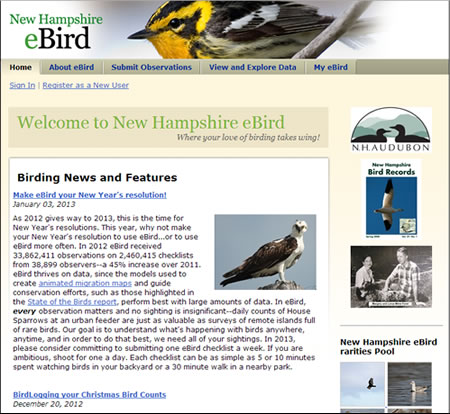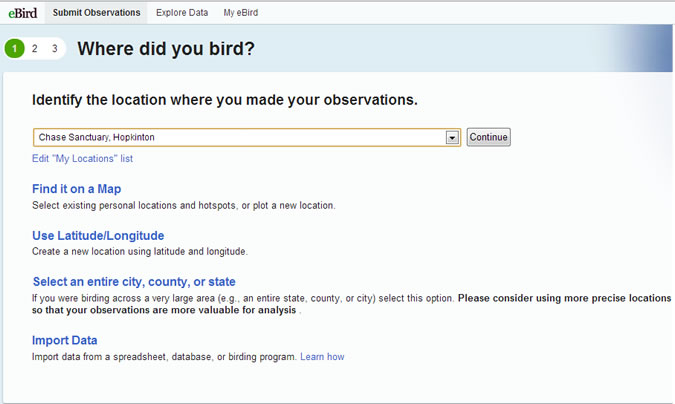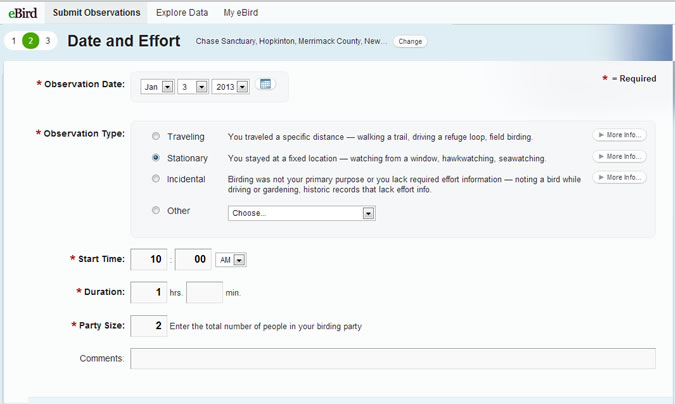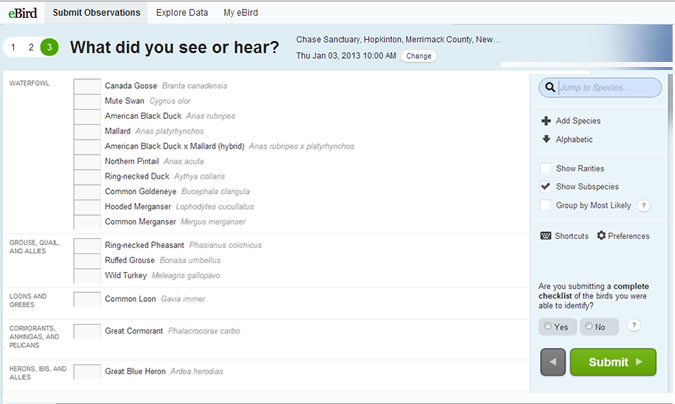Report Your Sightings to eBird

eBird is a free, user-friendly way for birders to record, archive, and share their observations on-line. It’s more than just a way to send your sightings to New Hampshire Bird Records, it’s also a personal records-keeping system, listing program, and resource for understanding bird distribution. On customized “My eBird” pages users can view their life, state and county lists—all generated automatically.
Setting up an account is quick and easy and once you have one, you can report sightings from anywhere, not just New Hampshire — and eBird wants all sightings, so you no longer need to wonder if what you’ve seen is “worth reporting.”
The eBird system is also different than New Hampshire Bird Records in that it wants some additional information to increase the usefulness of the data over time. It helps to become familiar with the system before you have lots of sightings to enter. Also, it is most helpful to try it out on a few small birding excursions first. Some of the basics are summarized below.
Submitting your sightings to NH eBird
eBird is designed to record what you see at a given location on a given day—somewhat reminiscent of the old fashioned field checklists for each day of birding at a specific place. Although eBird accepts more general locations (i.e., at county or state level), it functions best when locations are plotted specifically.
Any sighting submitted will be permanently available via your personal observations list and will automatically be tracked on your state, county, year, month, and life lists—eBird will automatically update your county and state lists for you based on sightings you enter, even if you don’t know what county you were in!
The primary means of reporting to eBird is via the web interface, and you will be presented with several options for mapping your location, including selecting from a list of birding Hot Spots and locations you have used before (“My Locations”) or plotting a new one on a map. Read more on the Location, Location page of this website.

By requesting effort information (i.e., how many hours you were there or how many miles you walked), it allows us to better understand bird abundance, and by promoting submission of complete checklists (all birds seen or heard), eBird can understand not only what species were found but what species were missed (which gives insight on trends in abundance). These data are then integrated with your personal records and lists and also with the master eBird database.

Based on your selected location, eBird provides a checklist of likely or possible species to choose from, checks for typographical errors or possible misidentifications, and allows you to enter counts, notes, and comments with your checklist.

If you already have a records keeping system, eBird provides a variety of tools to help convert your current bird records system to eBird.
Location, Location, Location
New Hampshire Bird Records editors review the sightings from a given season to look for patterns of occurrence, signs of migration, arrivals and departures, unusual sightings, and other interesting bird reports. They use the data to give them a picture of what happened that season and to choose which records to publish.
Please name your locations so that someone else can tell where you were. For example, “my backyard” will not mean much to someone who doesn’t know you, but “my backyard, Silk Farm Rd., Concord” will give them a good idea where you saw the bird. Local names can also be improved by adding more details. “Morrill’s Farm” will be better as “Morrill’s Farm, Merrimack River, Penacook.”
A good location name is helpful in many ways, whether it’s birders looking up sightings in eBird or New Hampshire Bird Records editors looking at sightings to publish. Adding the town is also be helpful (the New Hampshire Atlas and Gazetteer by DeLorme is a helpful resource for determining town boundaries), although this won’t be as necessary for well-known locations such as Odiorne Point State Park (already in the list of Hot Spots), the summit of Cannon Mountain, or Hampton Harbor. If you want to report a sighting from a town but not a specific location within the town, please use the option to “Select an entire city, county or state” under “Where did you bird?” and you can add notes on the location in the comments.
County-level sightings – Although you can enter sightings at the county level, it is not as useful to the editors or other researchers who might be looking at the data. If you have an interesting sighting and report it using just the county, please put information on the town and location in the Notes field. That will help the editors, and if we publish the sighting, we will be able to include that information for other interested birders.